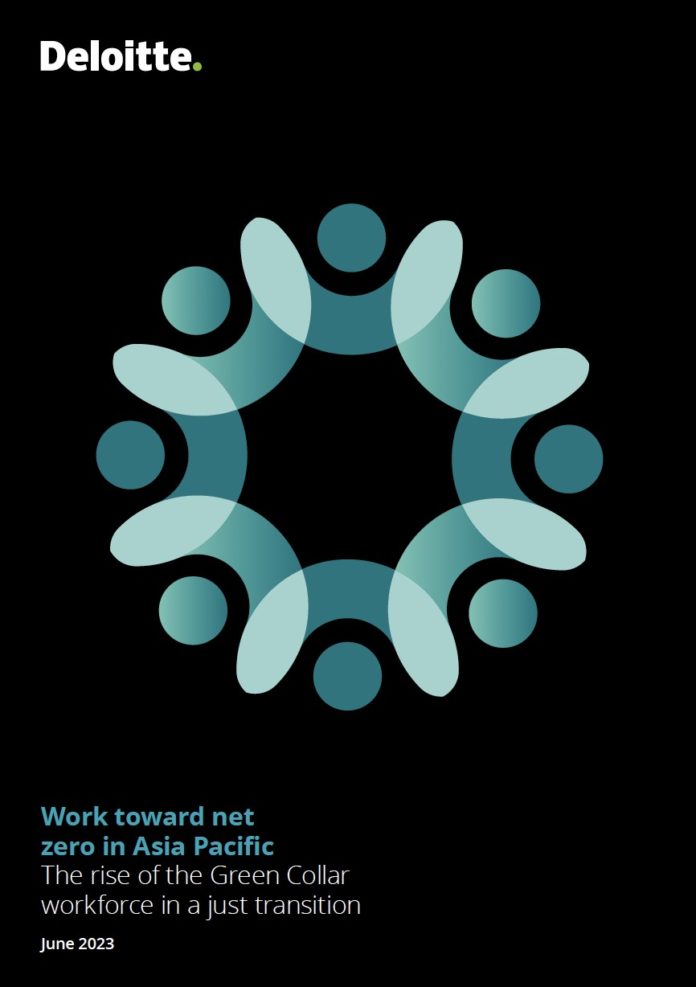A new report released by Deloitte highlights that Asia Pacific is starting to witness the rise of a Green Collar workforce and estimates that 80% of the skills needed for the low emissions transition in the short-to-medium term already exists in today’s workforce. However, 40% of these workers are currently employed in industries that are under threat from climate change and the transition to net zero.
The report “Work Toward Net Zero in the Asia Pacific: The Rise of the Green Collar Workforce in a Just Transition,” presents Deloitte’s Green Collar workforce policy agenda, and demonstrates how Asia Pacific governments can lead the way in tackling the climate crisis, while increasing resilience of those most vulnerable and ensuring equitable employment outcomes.
An investment in skills – to create a new Green Collar workforce – is necessary to realise the USD$47 trillion economic dividend identified from coordinated action on climate change. The report delves further into how policy measures aimed at investing in skill development can lead to a more equitable shift towards net-zero emissions globally, fostering additional social progress and economic prospects.
Will Symons, Deloitte Asia Pacific Sustainability & Climate Leader said: “Asia Pacific is exporting decarbonisation to the world, from renewable energies to innovation, and climate technology. The transition is already underway, and the success of global decarbonisation efforts will rely on the skills and expertise of the workforce across the region. By ensuring we prioritise this, we can avoid significant losses, promote economic growth and generate up to 180 million jobs in the region.”
Climate inaction is the greatest threat in the Asia Pacific
To identify the jobs most vulnerable to climate change and decarbonisation, the Deloitte Economics Institute developed the Job Vulnerability Index[i]. This methodology helps to pinpoint countries and industries across the Asia Pacific region where policy interventions are required.
Compared to the rest of the world, Asia Pacific countries face double the risk of being highly exposed to the physical impacts of climate change, as well as having high employment in industries that will face disruption from the low emissions transition.
According to The Deloitte Economics Institute, an estimated 43% of workers in the region are employed in vulnerable industries driven by climate change, such as agriculture, conventional energy, manufacturing, transportation, and construction. Minimising job disruption for climate-reliant jobs through investment in climate adaptation and accelerating the transition to net-zero will be critical for Asia-Pacific economies.
The rise of Asia Pacific’s Green Collar Workforce and the potential of 180 million additional jobs
As Asia Pacific countries step up their decarbonisation commitments, a new Green Collar workforce is emerging, characterised by new types of work, skills and occupations that will build our economy of the future. If Asia-Pacific countries seize the decarbonisation opportunity, they could add $47 trillion to the region’s economies by 2070 and create 180 million jobs by 2050.
Asia Pacific has strong pools of STEM talent, and the region is seeing significant employment growth in sectors like renewable energy. Reaching net-zero in less than thirty years will take nothing short of an industrial revolution and new types of work are required to achieve this. These occupations will fill demand in transitioning and entirely new industries. The renewable energy transition, for example, is causing a green jobs boom in the Asia Pacific. Almost two-thirds of the world’s renewable energy jobs are in Asia, with China alone accounting for 42% of the global total in 2022[ii].
Additionally, Asia Pacific governments are investing heavily in renewable hydrogen. Deloitte’s latest Green Hydrogen: Energising the path to net-zero report states that the emerging green hydrogen market is set to help reshape the global energy map by the end of the decade which will create US$1.4 trillion in the market by 2050.
In 2030, Deloitte predicts that Asia will capture 55% of this market, driven by skyrocketing demand in China, India, and Indonesia. China and Australia are targeting global leadership in hydrogen production and exports, while Japan and South Korea are leading in the research and use of green hydrogen. With strong pools of technical and engineering talent, Asia Pacific is well placed to build a skilled hydrogen workforce, but significant investment in training and education will be required. The Australian state of Queensland, for example, has already invested $50 million in training infrastructure to support the growth of renewable hydrogen[iii].
Dr. Pradeep Philip, Head of Deloitte Access Economics in Australia said: “Our analysis shows that 80% of the skills that will be required for jobs in our increasingly decarbonised economy already exist. It’s clear that these skills and the Green Collar workforce will be the driver of the transition—not a consequence of transition.”
Ensuring a just transition with public policy
The World Economic Forum warns that policy, investment choices and business practices will determine whether workers, companies and economies will thrive or be stranded in the low emissions transition[iv]. A focus on skills will be critical to enable workers to drive a just transition.
“How governments act individually and collectively to support these workers to adapt, contribute and thrive as our economy transforms will be one of the biggest determinates of equality in the coming decades. No country can do it alone, but together it is possible to influence a just transition where the benefits far surpass the cost,” Dr. Pradeep Philip added.

